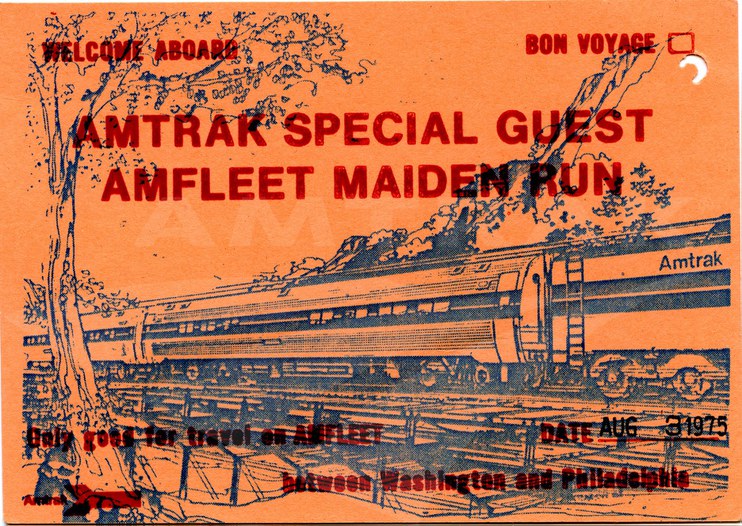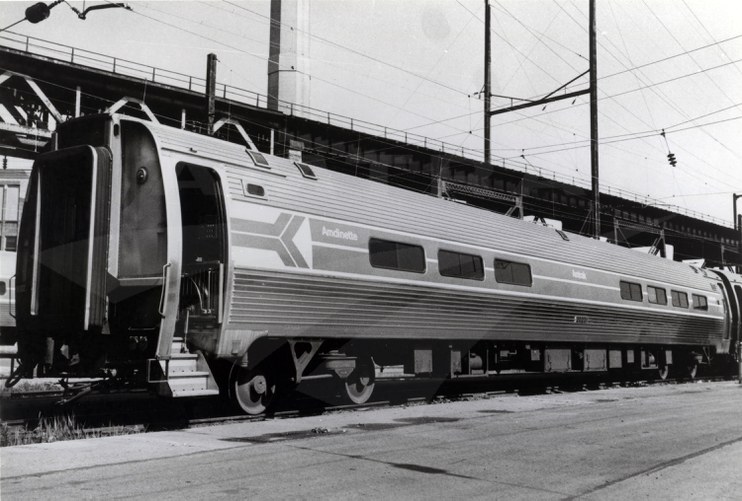Digging into the Archives: Introducing Amfleet
CommentsOctober 9, 2012
Updating the existing fleet of passenger cars and locomotives was one of Amtrak’s biggest challenges as it assumed responsibility for America’s intercity passenger rail system. In connection with the start of service in May 1971, Amtrak handpicked approximately 1,200 cars from a total pool of 3,000 held by the two dozen railroads that had been relieved of their passenger service obligations. Almost 90 percent of the cars chosen by Amtrak were either constructed of, or sheathed in, stainless steel, which meant lower maintenance costs.
Not surprisingly, Amtrak gravitated towards newer cars such as those belonging to the Atchison, Topeka and Santa Fe Railway (ATSF) and the Union Pacific (UP). From the former, it purchased 447 units, including 73 Hi-Level coaches, diners and lounges that were on average 10 years old. These well-maintained bi-level cars, popular with Western travelers, would became the basis for Amtrak’s new Superliner cars that entered the design process in 1973. The newest cars came from the UP, including coaches constructed as recently as 1965.
Mechanical and electrical overhauls were needed on roughly a third of the fleet, as were refurbishments to the interiors. Half of the cars were deployed on busy Eastern and Midwestern routes. In addition to much-used coaches, Amtrak bought 90 dome cars, 188 luxury coaches, 244 overnight coaches with leg-rests, 288 sleeping cars, 50 lounge cars and 140 dining cars of differing configurations.

Although much effort was put into modernizing the cars and painting them in the official Amtrak color scheme, the company began planning for the purchase of brand new stainless steel single-level and bi-level cars. The new single-level cars, later known as Amfleet I, were based on the design of the Metroliner. It was used as a prototype due to its popularity among travelers on the high-speed, luxury service between Washington and New York. Starting in late 1973, Amtrak would order the first of what was eventually 492 Amfleet cars; the 1974 Annual Report touted their “Floor tracks permitting variable seat spacing and other configuration changes [that] will allow us to maximize revenue as well as to provide varying interior arrangements.” To move the cars, 11 electric locomotives were also ordered.
Amtrak proudly proclaimed 1975 as “The Year of the Amfleet.” A two-page spread in the Annual Report featured photos of the Amfleet at work: a coach attendant stands tall and proud by the door; a café server shows off the new food offerings; business persons enjoy a drink in the club car; and a tired little boy curls up for a nap in his comfortable seat. By December, the Budd Company produced a finished Amfleet car every working day.
Designed to reach speeds of up to 120 mph, the tubular cars were covered in ridged stainless steel. Measuring 85’4” long over the couplers and 10’6” wide, Amcoaches weighed 106,000 pounds with Amcafes 4,000 pounds heavier. The Amfleet featured five car configurations:
- Amcoach (84 seats), primarily used in corridor service
- Amcoach (60 seats), used on long-distance routes
- Amcafe (56 seats), featuring a food service counter in the center of the car with seating at both ends
- Amdinette, which was a conventional Amfleet food service car with a diner section of eight tables occupying one-half of the car
- Amclub, which had coach seating in one half, a standard food service unit in the center and two-by-one club car seating on the other end
At the close of 1976, Amfleet equipment had spread beyond the East Coast and Midwest and was in use in California on the San Diegan (Los Angeles-San Diego) route; therefore, most short-haul trains employed the new cars. The Phase I paint scheme then in effect included wide red and blue stripes separated by a thin white line along the rows of windows on each side of the car. Amtrak’s inverted arrow logo was also prominent.

Commemorative ticket issued in August 1975.
Amtrak attributed ridership increases to passengers curious about trying out the Amfleet equipment. Advertisements touted the cars’ “dual temperature control system…plush carpeting…and wider, more comfortable reclining seats to relax in.” Drop-down tray tables allowed passengers to “…eat, drink or even get some work done, right at your seat.” Interiors employed the bold color schemes and patterns characteristic of the 1970s. In the timetables, Metroliner Service had long been designated by a special symbol as well as a callout in the column; now “Amfleet Service” was also highlighted to distinguish daily trains, such as the 164 (New Yorker), that used the equipment.
On-board crews trained to become familiar with the new car layouts. According to the Fiscal Year 1976 Annual Report, “Approximately 200 service attendants [this year] received the two-day Amfleet training program. This prepares attendants to serve in Amcafe cars by familiarizing them with the new equipment, proper storage and stocking procedures and good customer relations.” More efficient food service standards were instituted to take advantage of pre-portioned servings, frozen-food items and automatic beverage dispensing.
A year later, three overnight trains were equipped with Amfleet cars: the Panama Limited (Chicago-New Orleans); James Whitcomb Riley (Washington-Chicago); and Inter-American (Chicago-Laredo, Texas). To ensure compatibility with the Amfleet equipment, a few dozen sleeping cars used on those trains were converted from steam heat to electric power. By the close of 1977, the Budd Company had delivered the 406 Amcoaches and 86 Amcafes, and they were quickly pressed into service. Amtrak President and CEO Alan Boyd noted that because the bi-level Superliners did not arrive in 1978 as originally planned, there was a “…forced reassignment of Amfleet equipment to routes for which it was not designed…as older conventional cars have become increasingly unreliable an increasing number of long-distance trains have been changed to Amfleet operation.”

Amdinette at Philadelphia, 1970s.
Of the original 492 Amfleet cars, approximately 440 were still in service as of early 2012. Under the Capstone Program, many were refurbished in the late 1990s and early 2000s at the Bear Shops. Electrical and mechanical systems were overhauled, wheels and running gear renewed, and flooring, walls and seats upgraded. Important changes were made to the restrooms to ensure accessibility for all users.
Approaching close to four decades of service to America’s Railroad and its passengers, the gleaming Amfleet has itself become a symbol for Amtrak, particularly for travelers east of the Mississippi River.
-------------------------------------------------------------------------------------
In addition to the above links, sources consulted include:
National Railroad Passenger Corporation. Annual Reports for fiscal years 1975-1980.
National Railroad Passenger Corporation. Version 3.1 Amtrak Fleet Strategy: Building a Sustainable Fleet for the Future of America’s Intercity and High-Speed Passenger Railroad. Washington, DC: 2012




